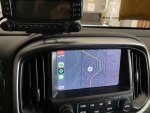@WanderingBison I like the sounds of it! That said, price delta goes in favor of choosing an LTE optioned iPad based on a brief Google search, right? I imagine the benefits lie with the external GPS supplying location to a variety of devices?
I'm not sure what the price difference might be, but if you don't already have either the iPad or the external GPS I'd think about just getting the cell-capable model and be done with it. There's not going to be any significant increase in position accuracy.
I will say one reason to get the stand-alone puck is flexibility in mounting. A device with built-in GPS no matter what it is - iPad, phone, Android tablet - needs to see the sky for GPS to work. This means on the dash or near a side window. Deeper inside the vehicle the performance *may* degrade. Not definitely will but could. With an external puck on the dash you can put the tablet anywhere you want as long as it can reach however you choose to connect, e.g. local Bluetooth or WiFi.
Another reason you might use an external is if you need higher than 1Hz refresh. Most GPS receivers for decades have updated their position once per second, e.g. 1Hz and this is still true of phones and tablets. Higher performance receivers can now update 5 or 10 times a second, e.g. 5Hz or 10Hz. Normally this is excessive and many of the additional points could get filtered later as redundant but in very twisty places or at high speeds (55 MPH is about 80 feet per second) the track will be more faithful to the actual route. I don't know that all external pucks offer 5 or 10Hz update but if they do and you want it then that's how you get it.
It’s probably very close to six of one, a half a dozen of the other.
Here’s why I like the external GPS receiver even though I chose a cellular iPad:
First and foremost, I can position the GPS receiver to get the best reception possible. You could even get an external antenna. We’re in a van, so that useful because the “cockpit” is blocked by a large chunk of metal to the rear.
Second, I can use the signal regardless of where I have the iPad. In my case, it’s sitting below the dash, between the seats where it wouldn’t get a great signal from the built in receiver. It works but I can certainly notice the difference.
Third, I use the tracks that GPS receiver records on its own to keep track of our routes, which doesn’t require running the iPad at all if I don’t need it.
Fourth, I can share the signal between devices - I use the GPS receiver for my iPad running GAIA and a few other navigation apps, my iPhone for accuracy and for a rig running my APRS setup. It also provides geolocation to a couple of other systems (solar, router) but that’s more complicated- this is not likely a very common use case.
From a cost stand-point, you can buy a quality, GPS/Glonass receiver once for a little more than the cost difference between a non-cell iPad and one with, and use it for many more years than the iPad. So buy once and use for multiple generation of your iPad.
It is a little more complicated, sometimes it doesn’t pair to my iPad on its own and requires you to keep another battery on another device.
So, it’s really about what you think you need and will use.
Sent from my iPad using Tapatalk


